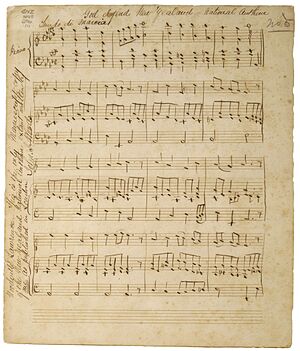John Joseph Woods facts for kids
Quick facts for kids
John Joseph Woods
|
|
|---|---|
| Born | 1849 Tasmania
|
| Died | 1934 |
| Partner(s) | Harriet Plunket |
John Joseph Woods was a talented New Zealand teacher and musician. He is famous for writing the music for "God Defend New Zealand". This song later became New Zealand's national anthem. Woods also worked for the Tuapeka County Council for 55 years.
Contents
John Woods' Life Story
Early Life and Moving to New Zealand
John Woods was born in Tasmania in 1849. He came from a large Irish family with fourteen other children. His father was a soldier. John taught in Tasmania for nine years. Then, as a young man, he moved to New Zealand. He worked as a teacher in several cities like Nelson, Christchurch, Dunedin, and Invercargill.
After eight years of teaching in New Zealand, he became the head teacher at St Patrick's School in Lawrence, Otago. He moved there in 1874.
A Talented Musician
John Woods was known as a very good musician. He was the choirmaster at the local Catholic church. This meant he led the church's singing group. He could play twelve different musical instruments! He was especially good at playing the violin. John even sang a solo at his own wedding, showing he was a great singer too.
While in Lawrence, John taught with Harriet Conway (née Plunket). She was an Irish widow with two sons. They got married in September 1874. Together, they had four more children: three sons and a daughter named Mary.
In 1902, Woods built a house made of brick and wood. He lived there until he passed away in 1934. Today, the Historic Places Trust looks after his house. They put a special plaque on the wall to remember him for composing the national anthem.
Composing the National Anthem
The Competition Begins
One winter night in June 1876, John Woods read about a competition. The Saturday Advertiser newspaper was looking for music to go with a poem called "God Defend New Zealand" by Thomas Bracken. John usually picked up his newspaper late in the evening. Even though it was 9 pm, he went straight to his piano. In just one sitting, he wrote the music for what would become the national anthem!
Later, he explained that the poem's words inspired him so much he had to write music for them. He sent his music to the competition using the pen name "Orpheus." The Advertiser sent his entry, along with eleven others, to Melbourne to be judged.
Winning the Prize
In October 1876, it was announced that John Woods' music was the clear winner! All three judges agreed. He won a prize of ten guineas, which was a good amount of money back then.
The competition rules said the newspaper would own the music's copyright. They gave the music sheet, called a manuscript, to Charles Begg & Co. in Dunedin to print. However, there were delays. The first printed version was very poor and only had one verse. The newspaper threw it out. When new copies weren't printed, the newspaper gave the copyright back to John Woods. He quickly arranged for his music to be printed in London.
John Woods had always called the song an "anthem," even though the poem's writer, Thomas Bracken, called it a "hymn."
An Anthem for Everyone
Since John was a choirmaster, he wanted his music to be simple. He made sure it was easy for children to sing. This helped the song become very popular!
On March 11, 1878, the Premier, George Grey, visited Lawrence. Six hundred local schoolchildren welcomed him by singing the song. By then, people were starting to call it the "national anthem." Grey loved the music and immediately sent a telegram to Thomas Bracken to congratulate him.
Working as a County Clerk
In 1877, John Woods stopped teaching. He became the county clerk for the Tuapeka County Council. He was known for working long hours, sometimes 13 hours a day! His accounting skills were so good that he became a fellow of the Registered Accountants of New Zealand. He also became an expert on county law. Other councils often asked him for advice. He even helped decorate the council office buildings for Queen Victoria's Diamond Jubilee in 1897.
He worked as the county clerk for 55 years! He retired in 1932 at the age of 83 because of poor health.
Other Achievements
John Woods was very involved in his town. He was a member of many local clubs and groups. He was also known for growing beautiful daffodil flowers. His collection was the biggest in the area! In 1884, he was chosen as the first president of the local choral society.
When John Woods was made an Honorary Freeman of New Zealand, he was praised for his "efficiency, integrity and devotion to duty." This means he was recognized for being very good at his job, honest, and dedicated.


